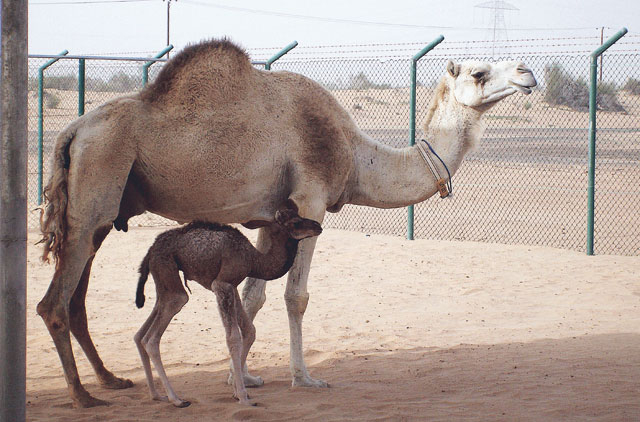Dubai: The Camel Reproduction Centre (CRC) on Sunday announced the birth of Victory, a dromedary camel calf born from a frozen embryo in Dubai.
CRC, in association with the Central Veterinary Research Laboratory (CVRL), performed the successful advanced ultra-fast freezing or vitrification, rehydration (thawing) and transfer of a seven-day old camel embryo.
Victory’s mother was treated with hormones to stimulate many oocyte-bearing follicles in her ovaries before she was mated to a chosen male.
Seven days later, doctors microscopically checked for the presence of embryos.
These were collected and vitrified, then stored in liquid nitrogen at -196°C for future use.
The embryos were thawed, rehydrated and transferred non-surgically into chosen recipient camels at five or six days after ovulation. Successful pregnancy was then diagnosed by ultrasound scanning 20 to 25 days later.
Vitrifying camel embryos
Dr Muren Herrid, formerly Head of Cell Culture at the CRC, has developed a protocol for vitrifying the camel embryos, which involves using higher concentrations of less toxic cryoprotectants than those normally used in other livestock species together with “open pulled straws (OPS).”
These OPS’s are very fine straws used to freeze the embryos in minute volumes of freezing media; a method developed by Professor Gabor Vajta and used successfully in sheep and cattle.
During the past two breeding seasons, pregnancy rates of around 50 per cent have been achieved following transfer of these vitrified/thawed camel embryos.
Freeze and thaw
Dr Herrid says his protocol differs from all other methods of vitrification because sucrose, used in the thawing process for other species, has proven toxic to camel embryos and has therefore been replaced with other sugars.
Dr Lulu Skidmore, Scientific Director of the Camel Reproduction Centre, says that this new ability to successfully freeze and thaw camel embryos is very significant as often more embryos than available recipients can be collected from the donor animal.
Now, the extra embroys can be vitrified and transferred at a later date as and when recipients become available.
It also means that the lengthy and costly procedure of trying to synchronise donor and recipient camels is unnecessary as the embryos can be frozen and stored until the recipients come naturally to the right stage of their cycle.
Freezing embryos also means that the valuable genetics of chosen combinations of male and female camels can be stored for many years.













